Key takeaways:
- Post-conflict recovery is a communal effort that highlights the importance of shared experiences and emotional healing.
- Fostering connections through storytelling and collaborative activities leads to unexpected friendships and builds trust within communities.
- The community plays a vital role in healing by providing support networks, cultivating resilience, and transforming collective grief into strength.
- Effective communication tools, including active listening and digital platforms, enhance understanding and maintain connections for long-term recovery.
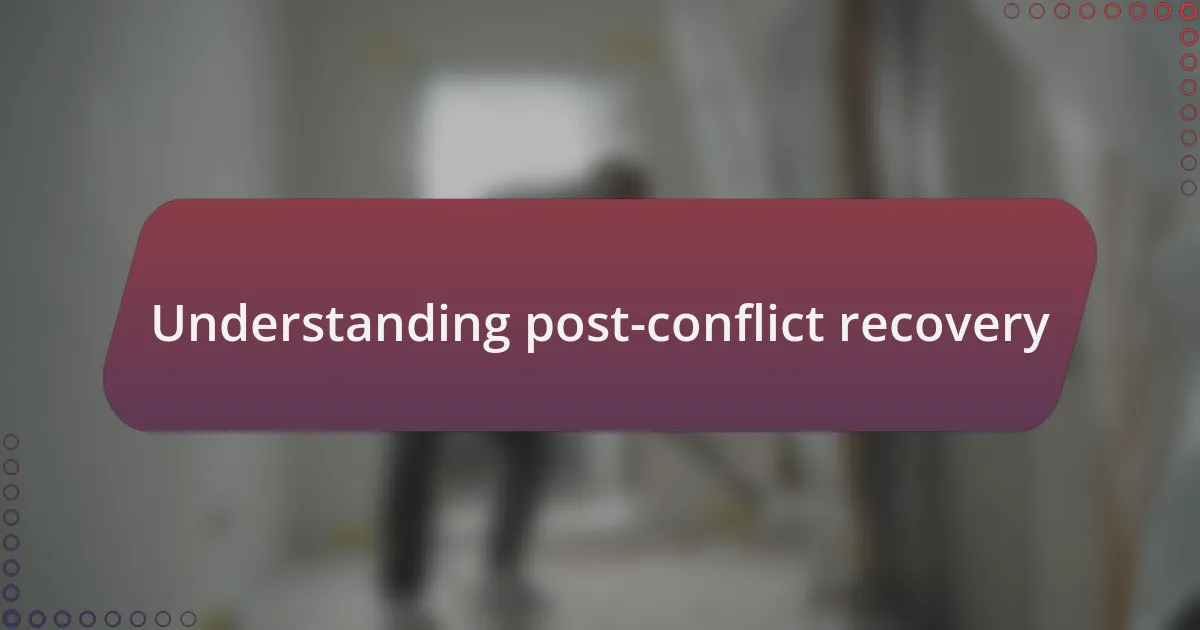
Understanding post-conflict recovery
Post-conflict recovery is a complex and layered process. It’s not just about rebuilding infrastructure but also about healing the emotional scars that war leaves behind. I recall meeting a woman who lost her family in a tragic conflict. She articulated her journey of recovery not just as a personal quest but as a community effort. Isn’t it fascinating how shared experiences can create a bond that transcends individual grief?
Often, recovery involves reconciling with painful memories while forging new relationships. I’ve seen communities come together, sharing their stories around small fires, turning their pain into collective strength. It made me wonder: can healing really happen without connection? In my experience, when people open up, they not only share their burdens but also create ties that help promote resilience.
Additionally, understanding post-conflict recovery means recognizing the role of trust in rebuilding communities. I once watched as two former adversaries shook hands during a reconciliation event. Their meeting was a powerful reminder of how essential trust is in the healing process. How do we foster that trust in countless stories of conflict? It often begins with individuals willing to listen and support one another, weaving a new narrative together from the fragments of their past.
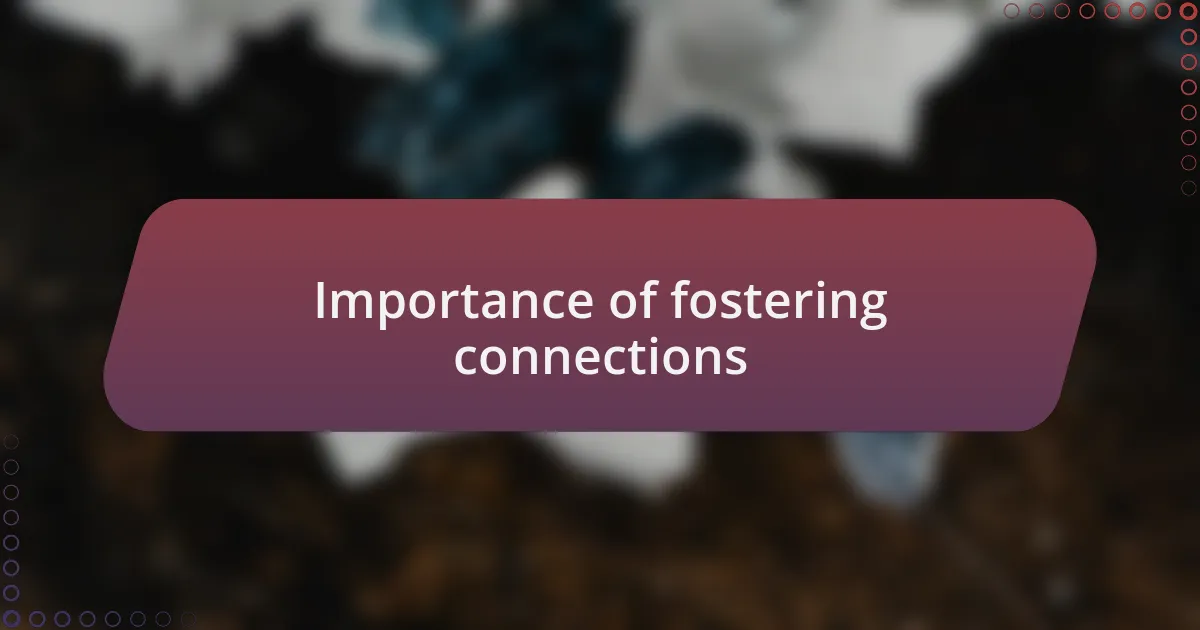
Importance of fostering connections
Fostering connections in a post-conflict context is not merely beneficial; it’s essential for restoration. I remember attending a community workshop where participants shared their stories. The vulnerability displayed was striking, and it reminded me how connection cultivates empathy and understanding among people who might otherwise remain distant. Can we truly heal alone?
In my observations, the act of fostering connections can often lead to unexpected friendships. I met a former soldier and a displaced mother who, through a shared community project, discovered common ground despite their contrasting backgrounds. Their laughter and collaboration became a symbol of hope, illustrating that connections help break down barriers and create new pathways for healing. Isn’t it empowering to think that unity can stem from acts as simple as working together?
Moreover, nurturing these bonds provides a support network that individuals can lean on during their healing journeys. I’ve witnessed how community gatherings can transform a shared space into a sanctuary where individuals feel safe to express their fears and aspirations. It raises an important question: how can we encourage more of these gatherings? By fostering an environment of inclusivity and support, we not only promote individual healing but also strengthen the resilience of the entire community.
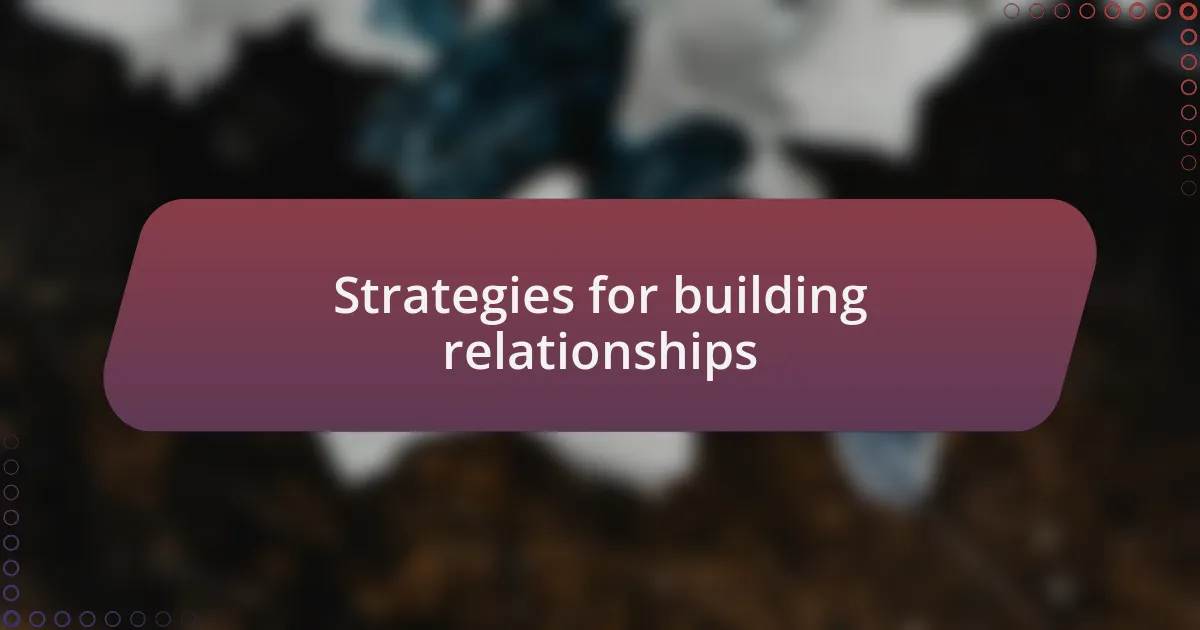
Strategies for building relationships
Establishing trust is a vital strategy for building relationships, especially in post-conflict situations. I remember a community leader who organized small, informal meetings for locals to voice their concerns without fear of judgment. This safe space encouraged attendees to open up, creating a supportive environment where trust could flourish. Isn’t it fascinating how trust can be built through simply listening and validating one another’s experiences?
Engagement in collaborative activities often serves as a bridge for connection. I once participated in a mural painting project alongside individuals from varying backgrounds. Initially hesitant, we gradually bonded over our creative efforts, as each brushstroke became a dialogue of shared hopes and dreams. Have you ever experienced how a simple joint task can foster understanding? The mural not only transformed a blank wall but symbolized the unity we forged through collaboration.
Taking the time to share personal stories can be another powerful way to build relationships. In one group discussion, I overheard a participant recounting a painful memory, and to my surprise, others began to share their own, leading to an emotional exchange filled with compassion. I realized then that vulnerability often opens the door for deeper connections. Can we afford to keep our stories in silence when they have the potential to bring us closer together?
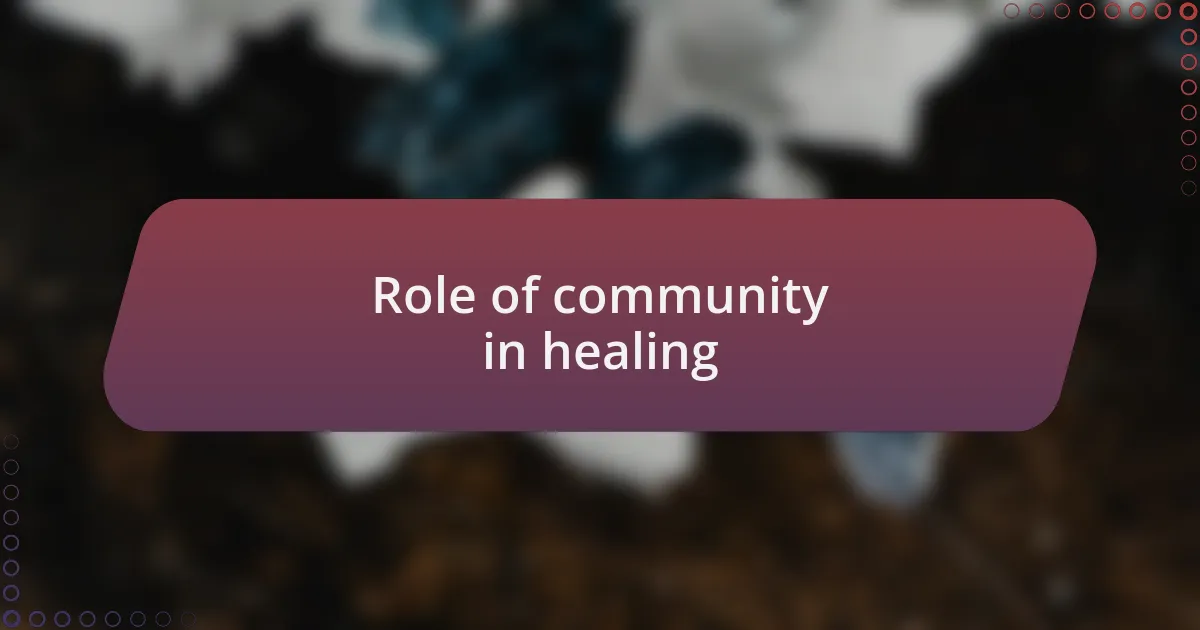
Role of community in healing
When it comes to healing after conflict, the community acts as a crucial support system. I remember visiting a local gathering where folks came together to share meals. The simple act of sharing food sparked laughter and conversation, creating a sense of belonging that is often lost in times of turmoil. Don’t you think the kitchen table can be a healing space, where heartache and joy intermingle?
In my experience, community rituals have the power to honor shared grief and promote collective healing. I once attended a remembrance ceremony that brought together people who had suffered loss. As we lit candles and shared stories, the atmosphere shifted; sorrow turned into solidarity. These shared moments reminded me that healing is not a solitary journey, but rather a communal one, and that collective grief can transform into collective strength.
Building connections within a community can also cultivate resilience in the face of adversity. I’ve seen neighborhoods come together to support local businesses after a crisis, turning what could have been despair into empowerment. Isn’t it remarkable how unity can fuel recovery, allowing individuals to rise together rather than struggle alone? The bonds formed during these efforts remind us that we are stronger when we stand side by side.
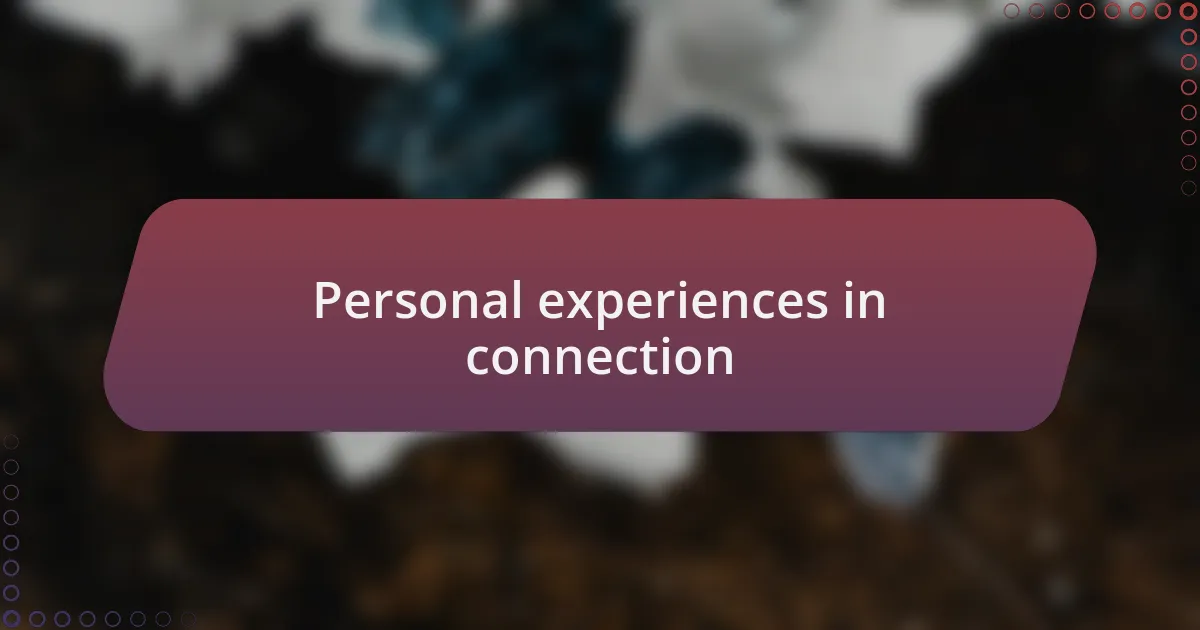
Personal experiences in connection
Reflecting on my personal journey, I can’t help but recall an unforgettable moment at a support group for survivors. When a stranger opened up about their struggles, I felt a wave of empathy wash over me. Sharing our stories felt like shedding a layer of isolation; we all left feeling lighter, as if we had woven a safety net of understanding together. Have you ever felt that rush of connection when someone lays bare their vulnerabilities?
There was also a time when I volunteered at a youth program that focused on rebuilding lives in the aftermath of conflict. The teenagers I worked with were initially apprehensive, but as we participated in team-building activities, I witnessed their walls slowly come down. It was enlightening to see how shared laughter and collaborative challenges fostered trust, creating friendships that transcended their past pain. Isn’t it fascinating how, through vulnerability, we can forge connections that empower us to move forward?
I remember an art project that involved community members expressing their experiences through painting. Each brushstroke told a story of resilience and hope. Watching individuals share their artwork and discuss the emotions behind them was profoundly moving. It struck me how much healing can occur when we come together to express ourselves. Could it be that our shared creativity becomes a powerful tool for connection, helping us heal not just individually, but as a collective?

Tools for effective communication
Effective communication hinges on the right tools that facilitate understanding. I once attended a workshop on active listening, and it was an eye-opener. By focusing wholly on the speaker, responding thoughtfully, and reflecting on their emotions, I discovered how conversations could transform into deeper connections. Have you ever thought about how simply listening can change the dynamics of a discussion?
Another powerful tool I’ve explored is non-verbal communication. During a poignant moment in a community event, I noticed how a comforting touch or a genuine smile could convey support more effectively than words ever could. It made me realize that our body language plays a significant role in expressing empathy. Have you ever felt more connected to someone in silence than in conversation?
Lastly, I find that digital tools can bridge distances, allowing even fragmented communities to connect. When we established a group chat for individuals affected by conflict, it created a space where emotions and ideas could flow freely. It was inspiring to see how a simple message could spark hope and encouragement, highlighting the importance of accessibility in communication. Isn’t it remarkable how technology can foster bonds that transcend physical barriers?
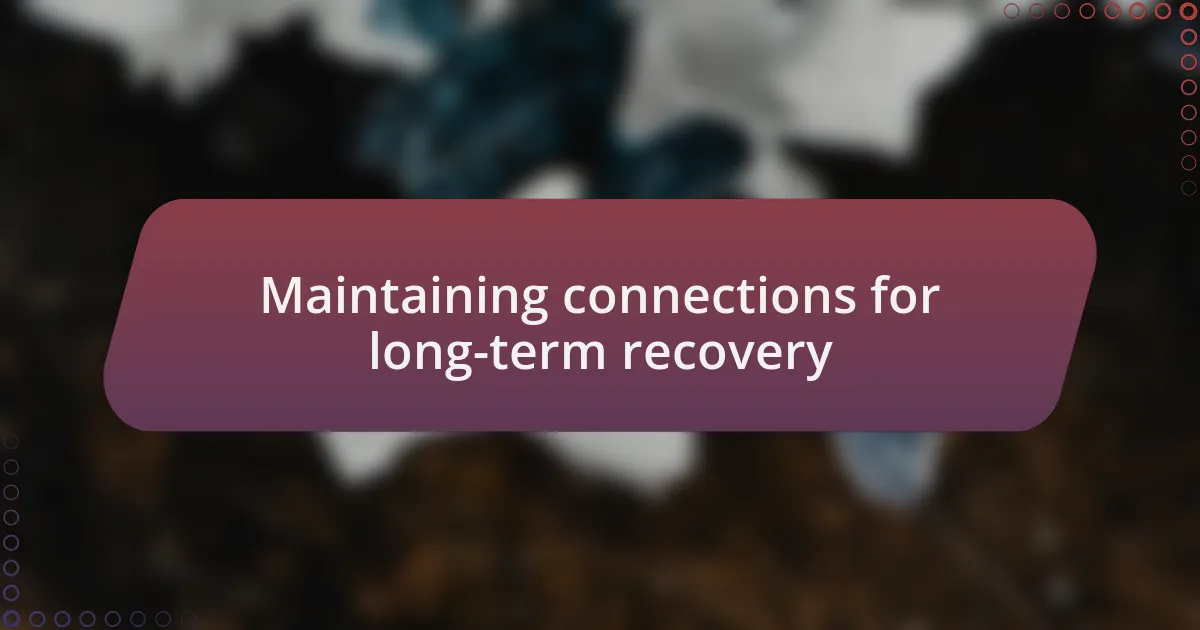
Maintaining connections for long-term recovery
Maintaining connections in the aftermath of conflict is crucial for fostering long-term recovery. In my experience, I have seen firsthand how regular check-ins with friends can serve as a lifeline. For instance, during a particularly challenging phase in my own recovery journey, simple texts and phone calls from those I cared about offered solace, reminding me that I wasn’t alone in my struggles. Have you ever felt a rush of comfort from just knowing someone is thinking about you?
Building your social network intentionally can be transformative. I remember attending community meetings where we shared our experiences and frustrations. It was during those gatherings that I felt a sense of belonging and solidarity, realizing that shared stories can bind us together. Have you thought about how participating in group activities or volunteer work could create a supportive community around you?
The act of maintaining connections also requires effort and commitment. I learned this when I initiated a monthly coffee meet-up with friends who shared similar experiences. At first, it felt like just another obligation, but it soon turned into a cherished ritual, where laughter and tears coexisted freely. How might your life change if you invested in regular gatherings with your support system? By putting in the time and energy, those connections blossomed into something that nourished my soul.